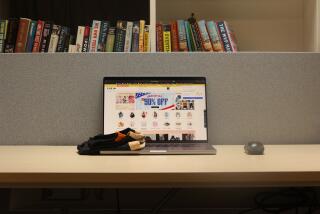BY DESIGN : The Bittier, the Better : You <i> can</i> live with a tiny purse. But it takes some work and creativity--not to mention being able to think small.
- Share via
It sits there staring at you. Your new small handbag with the firm sides, the pert handle, the crisp clasp. It reminds you of Jackie O., Grace Kelly and, yes, you must admit, the Queen Mother. It’s going to make you ever so chic and ladylike for spring. It’s also going to drive you crazy.
What, you wonder, will you ever squeeze inside? Where can you go without your cellular phone, your Filofax, your sunglasses, your reading glasses, your four lipsticks, three eye shadows, two blushes and one mascara wand?
You’d be surprised. Just take it from women who have already downsized and minimized. They have turned packing a bag, sometimes no bigger than a paperback novel, into an art and a science.
Their cellular phones stay in their cars. They carry small electronic date books and folding glasses or antique lorgnettes. In place of wallets, they might slip in just one credit card and a few bills fastened by a money clip.
Their pens, paper, combs, mirrors and such are scaled down to Lilliputian proportions. In some cases, they have become so small-minded, as it were, that they leave pre-packed bags on their closet shelves.
Finding the next tiny accessory becomes an amusing game, played with friends who share information and gifts. But for handbag designer Timmy Woods, downsizing is also serious business.
After an automobile accident two years ago, Woods says her doctor told her not to carry big loads of anything. She began scaling down and in the process created a line of small, sculptured handbags.
When Woods gets to her destination, she puts the bag--containing nothing more than credit card, small Gucci pen and paper set, lipstick and sunglasses--on a table, as if it were a work of art.
Little bags seem destined for display. They are rarely shoved under a restaurant table, for example. Glen Miller, who designs small structured handbags for Ann Turk, even calls the genre “a restaurant bag. It’s there to admire while you have dinner.”
“They’re like children’s bags,” opines Suzanne Marx, a Los Angeles-based fund-raiser who is partial to the Hermes Kelly bag, in small, medium or large.
“It’s a baby,” she says of the smallest one, which measures 4 by 5 inches and miraculously accommodates a Tiffany folding mirror, sample-size Bulgari perfume, mini breath spray, linen handkerchief, paper-thin Chanel rouge case, lip liner, lipstick, credit card, “a couple of dollars for parking,” fold-up non-prescription glasses, and a small sterling silver pen and pad from Asprey in London.
Small-bag addicts must forever weigh the options. In Marx’s case, she can live without certain essentials, including a comb. “I just run my hands through my hair,” she says. But as a fund-raiser, she must have paper and pen. After any social event, she says, “I might come home with 10 pages of notes.”
Despite such bare-bones minimalism, placement is everything.
“You have to engineer it; you can’t just throw things in,” explains Rosalind Millstone, a Los Angeles design and color consultant who eschews a large bag because, she explains, “it’s a temptation to carry things that one doesn’t need.”
“As my purses got smaller, I began to enjoy them more,” she says. “I began to pick up small things to go with them. You don’t need a big compact. You don’t need a big anything.” She packs a 6-by-4-inch purse (her largest) with a small Swiss army knife, wallet, credit-card case, flashlight on a key chain, silver Tiffany comb, mirror, spray atomizer and antique lorgnette.
*
Millstone evolved into a small-purse person. But singer-songwriter Carol Connors says she was born to be one. Virtually everyone in her family, including her father, a former jockey, is short. “My whole life is in miniature,” she says. “The first house we lived in was like a dollhouse.”
Now she carries doll-like purses, many of them by K. Baumann Design. Inside are a miniature pen and monogrammed stationery from Melrose Design in L.A., because, Connors says, “I never know when I’m going to get an idea.”
They are strategically aligned with a tiny Shaklee lip gloss and lip brush, and the small Everything Pencil, a concealer sold by makeup artist Judith August. Connors breaks other makeup pencils in two to get them down to the right size, and she eagerly accepts such miniature freebies as airline combs and hotel sewing kits.
“British Airways always has good miniatures,” says Judy Knapp, co-owner of the eponymous Los Angeles apparel company. So does the Beverly Hills Beauty Center, where Knapp bought a five-section compact that she fills with “a dab of everything,” including concealer, eye shadow and face powder.
To get a dab of lipstick, Knapp refrigerates the tube “so it’s nice and solid, then I slice a bit off. You create your own little things,” she says, summing up the tiny-bag technique, which, for some, includes the tiny-bag transportation code.
Basically, you do not want to look like the Queen Mother, something Robin Piccone, the L.A.-based swimwear and sportswear designer, discovered with one of her little bags. “I can’t slip it over my wrist or crook of my arm as they did in the ‘40s, because when I catch sight of myself in the mirror, it looks silly to me,” she says. “I just carry it in my hand.”






